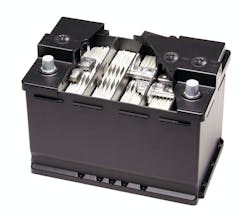Battery composition and construction have changed more in the last six to eight years than they have in the prior four decades, according to Jim O’Hara, vice president of marketing for Clore Automotive Inc. More changes are coming fast as automotive manufacturers prepare for the federal government’s corporate average fuel economy (CAFE) standards, which set a 54.5 miles per gallon average fuel-efficiency goal for the 2025 model year.
Automakers are relying on a variety of technologies to boost the fuel efficiency of standard combustion engines. These technologies include low-rolling resistance tires, advances in electric motors that power vehicle components, turbochargers, gasoline direct injection systems that more efficiently burn fuel, and new methods for energy storage.
Among the latter, automatic start-stop systems have emerged as one of the preferred technologies for meeting aggressive fuel economy and carbon emission reduction targets by enabling as much as 5% fuel economy savings over a conventional vehicle, according to Dale Gospodarek of Johnson Controls Inc.’s Power Solutions division. He predicts most new cars will be equipped with start-stop systems in five years. Marcel Ayasse of Robert Bosch LLC expects original equipment manufacturers to equip half of their models with start-stop systems and absorbent glass mat (AGM) batteries by 2017. In a study released in April 2015, Navigant Consulting Inc., a market research and consulting firm that provides analysis of global clean technology markets, concluded start-stop vehicles will account for 55% of all vehicles sold worldwide by 2024.
AGM is becoming standard
“The AGM battery is quickly becoming the standard battery as OEs try to meet the power requirements of today’s vehicles,” says O’Hara. “With the rapid emergence of start-stop engine management systems designed to increase fuel efficiency, the onset of AGM domination is in fact speeding up.”
Automatic start-stop systems turn off the engine when a vehicle is at a complete stop and restart it when driving resumes. O’Hara offers two examples of popular vehicles with start-stop technology. The 2015 Ford F-150 EcoBoost uses start-stop technology with a single AGM battery, and the 2015 Chevy Impala uses start-stop technology with a two-battery configuration (the second auxiliary battery is located in the trunk). “We believe that independent tire dealers who offer a full menu of repair services should be much more focused on current changes in battery technology,” he says.
Start-stop systems use either AGM or enhanced flooded battery (EFB) technologies. Both technologies are used by European original equipment manufacturers. Johnson Controls’ batteries power start-stop vehicles for every major automaker in Europe. “Consumers have been quick to accept start-stop with AGM and EFB because there is minimal impact on the driving experience, and there isn’t the range of anxiety associated with plug-in electric vehicles,” says Gospodarek, who is vice president of marketing and strategy for aftermarket U.S. and Canada in the Power Solutions division.
Will Sampson, executive director of marketing for Midtronics Inc., says new battery chemistries are designed to help the start-stop battery work better in a partial state of charge. “This means different performance criteria, like charge acceptance, also become more important since after each engine start the battery needs to more quickly recover in order to support the next start-and-stop event. AGM batteries are a strong alternative for this application, but cost more. EFB batteries are a lower-cost approach to provide similar capabilities.”
However, EFB technology is not relevant for the U.S. aftermarket yet, according to Ayasse, who is senior product manager of batteries and battery chargers for Bosch’s Automotive Aftermarket N.A. division.
“Knowing from the past that it takes about three to five years until battery trends come over from Europe to the U.S., combined with the standard aftermarket delay of about three years, this technology will hit the market in about five years at the earliest.”
[PAGEBREAK]
AGM is spreading quickly
“AGM technology on the other hand, has certainly arrived in the U.S.,” says Ayasse. “We expect to have an OE equipment rate of about 50% in 2017. All big retailers have AGMs on their shelves and the segment is showing strong growth.”
In addition to powering start-stop vehicles, AGM technology is a great upgrade option for vehicles with flooded batteries because they yield a high energy capacity that can handle a number of demands simultaneously and sustain that high level consistently over a long period of time, according to Ayasse.
“Today’s vehicles, with a host of power-robbing accessories like power windows, power seats, powerful sound systems, and an array of lights to perform different functions ranging from reading maps to playing games, not to mention antilock brakes, electronic stability control and air conditioning, require a battery that can handle the demand, and AGM can deliver,” says Ayasse.
Gale Kimbrough, engineering and technical manager for Interstate Batteries Inc., says dealers can expect to see start-stop vehicles in their shops soon because restarting the engine multiple times places tremendous strain on the vehicle’s battery. The car’s accessories challenge the battery even more.
“When a start-stop vehicle comes to a stop and the engine shuts off, people continue to desire their vehicle creature comforts. No one wants the vehicle’s heater to quit when it is 10 degrees outside in Ohio or the air conditioning to slow down or quit when it is 110 degrees in Dallas or Phoenix.”
The battery in a start-stop vehicle has to create energy to power lights, computer and ignition systems, and other accessories. “That power request may be 30-50 amps for several minutes at a time while the battery is required to hold on to adequate voltage to restart the vehicle the second you press the accelerator. A morning commute with 10 stops plus 10 restarts one way could add up to a tired battery within a short time,” says Kimbrough.
Sampson says dealers need to learn more about and understand start-stop systems. “Unlike many other car services, I would expect tire dealers to see this opportunity fairly soon since tire service is more of an aftermarket opportunity, even with vehicles that are still in the warranty period.”
Begin preparing for AGM
How can dealers prepare their shops and their techs for AGM battery technology? Start with specialized AGM-compatible charging equipment and AGM-specific testing equipment. “If shops are not equipped with the right tools for the job, they will be forced to do one of two bad things, turn customers away or poorly service and even damage their vehicle. There is no reason for such an outcome,” says Clore’s O’Hara.
In addition, dealers need to start evaluating and investing in newer diagnostic and maintenance equipment that will allow them to provide battery and electrical service and maintenance as the vehicle population evolves, according to Sampson. John Munsell, battery product specialist for General Motor Corp.’s ACDelco brand, says AGM batteries will become the dominant technology for start-stop vehicles in the near future due to their charge receptiveness and ability to tolerate a very high depth of discharge. “In order to prepare shop owners for this technology, it is ACDelco’s recommendation that any offline charger that is used on AGM must have an AGM switch on it,” he says.
The switch sets maximum voltage around 14.5 volts at room temperature. “Charging an AGM on a flooded battery charger, which is around 15.5 volts, for less time will not work and may indeed harm the battery. This is again because of the AGM battery’s charge receptiveness. Charging an AGM battery at a higher voltage for less time will create heat inside the battery and may result in gassing. This gassing can deplete the battery of the electrolyte inside the glass mat and can result in premature failure of the battery,” he says.
Jennifer Eirich, marketing manager for Odyssey brand batteries manufactured by EnerSys Inc., suggests training for technicians place less emphasis on battery chemistry and more emphasis on batteries and automotive electrical systems. She says become familiar with today’s “smart” chargers and educate technicians on battery identification as some new products, namely new lithium batteries and super capacitors, may be mistaken for traditional batteries. Safety training refreshers are necessary, too. “When handling a variety of batteries it is important to stay current. Make sure you have the right type of fire extinguisher for the battery chemistry on hand.”
Bosch’s Ayasse says that for an upgrade job, the shop only needs to replace the battery. Usually, no calibration of the electrical system is required. However, if the vehicle has a start-stop system and AGM battery, then an extra step is needed.
“After replacing the battery, which works much the same as replacing a flooded battery, the technician will need to tell the battery management system about the specs of the new battery so it gets charged correctly. That system calibration may require specific tools depending on the vehicle,” says Ayasse. Additionally, charging an AGM battery requires a special charger that is suitable for AGMs. Otherwise, a 100% charge is unlikely to be reached.
For traditional internal combustion engines, most replacements are purchased after end-of-life of the existing battery, says Johnson Controls’ Gospodarek. But this is not the case for start-stop applications.
“To gain the benefits of the start-stop system in terms of reduced CO2 for the environment and lower fuel consumption for consumers, the battery will need to evolve into a planned-maintenance replacement item to enhance the consumer experience, much like changing your tires,” he says. “It is important to realize regular battery replacement is required over the vehicle lifetime to ensure full start-stop system benefit to consumers.” ■




